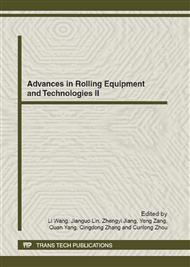p.187
p.193
p.198
p.203
p.210
p.215
p.221
p.227
p.232
Study on Diagnostic Strategy for Plate Camber
Abstract:
During the past two decades, progress has been achieved for the plate production in various areas, from the level of equipment to the processing techniques, and from the product size to the quality of the products as well. However, plate camber which may affect the stability of rolling has been one of those thorny problems due to the complexity and variation of plate camber. Analysis of the factors which may lead to plate camber, including slab wedge, temperature uniformity across the plate width, side-guide alignment, stiffness difference at two sides of the mill and the inclination of the roll gap, the features of the plate camber have been studied. Using measurement and quantitative analysis of plate camber, process data analysis of the plate, equipment monitoring and operation adjustment, a systematical diagnostic strategy of plate camber has been carried out. It has shown that the developed diagnostic strategy is satisfactory in one domestic Plate Mill.
Info:
Periodical:
Pages:
210-214
Citation:
Online since:
October 2012
Authors:
Keywords:
Price:
Сopyright:
© 2012 Trans Tech Publications Ltd. All Rights Reserved
Share:
Citation:


